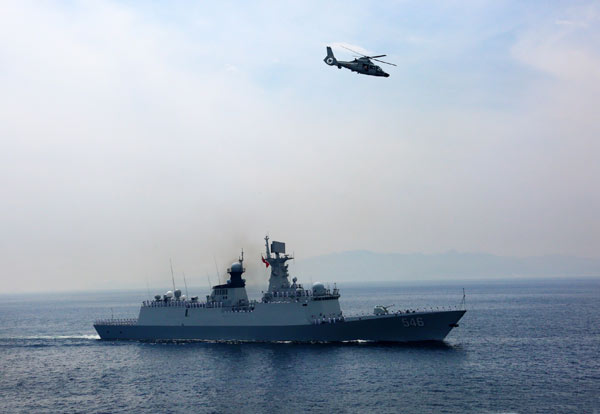 |
| A missile frigate and helicopter join in the maritime memorial ceremony on Aug 27. CHA CHUNMING / XINHUA |
| Related Video |
Protecting territory
|
Time to steer Chinese maritime power into the mainstream First Person | Yang Guozhen Yang Guozhen is the former director of the history department of Xiamen University. He was one of the first maritime history researchers in China and founded studies of the subject at Xiamen University in 1991. I was born in Fujian's Longyan city and moved to the coastal city of Xiamen in 1949. So I have experience and became interested in maritime culture and history in my early life. As I continued my research in maritime history, I found that the development of maritime power had never been valued in China, although we had the maritime Silk Road and far sea voyages as far back as thousands of years ago. The heart of Chinese culture has been attached to its agrarian tradition, which was developed from the inland areas. But a country won't prosper without developing its maritime power, which is supposed to be open, creative, adventurous and even aggressive. My studies try to generate greater attention on the research and development of oceans, to think globally. When the 15-century explorers sailed into uncharted waters, maritime trade fueled the economy of the West and launched its history of expansion. China actually had the opportunity to build its maritime power in ancient times but chose to close our doors, for which we have paid a price. But now China has another opportunity to develop its maritime power. First, great attention should be paid to China's maritime rights, including protecting its maritime territory. China still faces a complicated international situation and increasing tension in our maritime territory. Second, China needs to explore and develop ocean resources and protect the environment at the same time. China is not only an inland country. It also has long coastallines and huge maritime territory. Whether China can rise as a great nation depends on how we develop and use maritime power wisely. Yang Guozhen was talking to Peng Yining |
"Oceans are not just seaways, they also have economic and military value," Wu Shengli said. "We are not just exploring the coastal waters, but will also develop the deep and far seas."
China has been protecting its maritime territory and will look to larger influence over international maritime issues, Wu said.
In July 2012, China established Sansha city, with its government seat on Yongxing Island, to administer the Xisha, Zongsha and Nansha islands and their surrounding waters in the South China Sea.
Two month later, China's first aircraft carrier, Liaoning, was launched.
Peace Ark, the PLA navy's hospital ship, has completed five humanitarian missions in more than 20 countries in South Asia, Africa and South America in the past four years.
The 17th escort fleet sailed in March and participated in the search for missing Malaysia Airlines flight MH370, before heading to the Gulf of Aden.
China has been fully involved in international maritime affairs and will be participating in a larger and wider scale, Wu said.
"But to some extent, China still needs to improve the awareness of maritime power," said Jin Hang, military expert from the PLA navy's East Sea Fleet.
Jin took the Millennium Monument, a landmark located in Beijing, as an example. He said the monument has only laid out yellow tiles to symbolize China's 9.6 million square kilometer land territory, neglecting the coastal areas. Many elementary and middle school geography textbooks also have no maps of China's maritime territory, he said.
Most Chinese know the size of China's land territory but few know the country also has 80,000 square kilometers of blue territory and 3 million square kilometers of waters on the continental shelf, Jin said.
"As it builds a strong navy, China should also keep exploring and developing its maritime territory," Jin said. "And people should know more about maritime power through textbooks, maps and museums."
The museum of the First Sino-Japanese War of 1894-1895 on Liugongdao is shaped like a battleship. On the entrance at the head of the ship, there is a statue of an admiral of the Qing Dynasty looking east through a telescope.
In front of the statue, there is a sculpture of a half-sunk cruiser representing a battleship destroyed by the Japanese and China's defeat.
"It takes courage to rethink about the shame of the Jiawu War," said Li Qiucheng, 47-year-old tourist from Hebei province.
"China has learned the lesson from the war and we won't let history repeat itself."
Contact the writer at pengyining@chinadaily.com.cn
